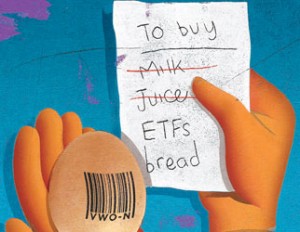Here’s an example. Say you have $50,000, and you’re jittery about the markets and discouraged by the low rates on savings accounts and regular GIC rates. Your advisor suggests a PPN like this one from Bank of Montreal, which guarantees your investment for six years and adds some possible upside based on the performance of the S&P/TSX 60 Index of large-cap Canadian stocks. No risk of loss and the potential to benefit from a stock market rally: what’s not to love?
A lot, actually. Read the fine print and you’ll learn that the product carries a 3% sales commission, which will cost you $1,500 right off the top, plus a deferred sales charge if you sell it within two years. Like all PPNs, this note also places significant limits on your upside that effectively mean the markets have to shoot the lights out for you to get any meaningful return. (The benchmark used by these notes almost never includes dividends.) I would explain the formula if I understood it, but I don’t. You’re welcome to read the 24-page offering document and figure it out yourself.
A homemade option
A better solution is to forget about this complex and expensive product altogether and build your own for a fraction of the cost, and with a much greater potential for added returns. Here’s how:
1. Start by determining the current yield on six-year strip bonds. A strip bond (also called a zero-coupon bond) doesn’t make interest payments like a traditional bond. Instead, you buy it at a discount and it matures at face value. You can find a long list of them at any discount brokerage. Investment-grade strip bonds maturing in 2018 currently have an effective yield of about 2%. (Note that strip bonds should only be used in a tax-sheltered account.)
2. Download this spreadsheet, which I’ve created to do the math for you. Fill in the three highlighted fields: the amount you wish to invest ($50,000), the number of years (6), and the yield on your strip bond (2%). The spreadsheet will give you a present value of $44,399. In other words, this amount compounded at 2% for six years will grow to $50,000.
3. Now it’s time to purchase the investments. Start by buying your strip bond in the amount of $44,399. Then use your remaining $5,601 to purchase an equity ETF such as the Horizons S&P/TSX 60 ETF (HXT), which tracks its index almost perfectly and conveniently reinvests all dividends.
Now, unless your bond defaults, you are guaranteed to have $50,000 in six years, plus some additional return that is tied to the performance of large-cap Canadian stocks. But unlike the structured note, there is no limit on that potential upside: your $5,601 will capture everything the index delivers, minus only the ETF’s minuscule fee.
Plus, you don’t have to rely on a 24-page offering document or Newtonian calculus to get an idea of your potential returns. My spreadsheet calculates these based on several scenarios, using both negative and positive values for the ETF. For example:











